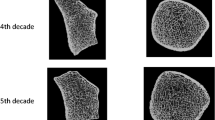Abstract:
Vertebral morphometry, the quantification of vertebral body shape, has proved a useful tool in the identification and evaluation of osteoporotic vertebral deformities in both epidemiologic surveys and clinical trials. Although conventionally it has been performed on lateral radiographs of the thoracolumbar spine (morphometric radiography, MRX), it may now be accomplished on morphometric X-ray absorptiometry (MXA) scans, acquired on dual-energy X-ray absorptiometry (DXA) machines. In this study the long-term precision of vertebral height measurement using MXA and MRX was directly compared. Initially 24 postmenopausal women were recruited (mean age 67 ± 5.8 years): 12 normal subjects (group 1) and 12 with osteoporosis and known vertebral deformities (group 2). Each subject attended for a baseline visit at which they had a MXA examination and lateral thoracic and lumbar radiographs. Twenty-one subjects then returned 1.7 ± 0.4 years later (10 subjects from group 1 and 11 from group 2) for a follow-up visit to repeat both the MXA scans and conventional radiographs. The baseline MXA scans and conventional radiographs were each analyzed quantitatively by two observers in a masked fashion, using a standard six-point method. The follow-up images were then analyzed by the same observers. The MRX observers were masked to the baseline analyses, while the MXA observers utilized the manufacturer’s ‘compare’ facility. On all scans and radiographs anterior (Ha), mid (Hm) and posterior (Hp) vertebral heights were measured and wedge (Ha/Hp) and mid-wedge (Hm/Hp) ratios calculated for each vertebral body, ideally from T4 to L4. MRX analyzed 129 of the 130 available vertebrae in group 1 at both visits and 141 of the 143 available in group 2, while MXA analyzed 124 vertebrae in group 1 at both visits and 127 in group 2. Intra- and inter-observer precision errors, particularly in terms of coefficient of variation (CV%), were larger for MXA than for MRX in both normal subjects and those with vertebral deformities. For example, intra-observer precision errors for vertebral height measurement were 0.62 mm (2.9%) for MXA compared with 0.63 mm (2.2%) for MRX in group 1 (normal) subjects and 0.82 mm (4.2%) for MXA compared with 0.85 mm (3.3%) for MRX for group 2 (osteoporosis and vertebral deformities) subjects. Both MXA and MRX inter-observer precision was clearly poorer than the intra-observer precision, a problem associated with any morphometric technique. This was particularly noticeable for MXA; for example, precision of vertebral height measurement in group 1 subjects was 0.62 mm (2.9%) for intra-observer compared with 0.99 mm (4.6%) for inter-observer analyses. MXA and MRX intra- and inter-observer precision was significantly poorer for subjects with vertebral deformities compared with those without, with the CV% for subjects with vertebral deformity approximately 50% greater than that of normal subjects. For example, MRX intra-observer precision for the mid-wedge ratio was 2.6% for group 1 subjects compared with 3.8% for group 2 subjects. The precision of vertebral height measurement on deformed vertebrae of group 2 subjects was poorer than that for normal vertebrae in the same subjects using both MXA and MRX, as a result of increased variability in point placement. For example, MXA intra-observer precision (RMS SD) for the wedge ratio precision was 0.037 (3.9%) for normal vertebrae compared with 0.060 (6.6%) for deformed vertebrae. We conclude that MXA precision was generally poorer than MRX, although both techniques were adversely affected by the presence of vertebral deformities and the use of more than one observer. Although precision errors for both techniques were substantially smaller than the 20–25% reduction in vertebral height frequently proposed to identify incident deformities, the poorer precision of MXA may lead to an increased risk of erroneous classification of vertebrae as normal or deformed.
Similar content being viewed by others
Author information
Authors and Affiliations
Additional information
Received: 17 December 2000 / Accepted: 12 September 2000
Rights and permissions
About this article
Cite this article
Rea, J., Chen, M., Li, J. et al. Vertebral Morphometry: A Comparison of Long-Term Precision of Morphometric X-ray Absorptiometry and Morphometric Radiography in Normal and Osteoporotic Subjects . Osteoporos Int 12, 158–166 (2001). https://doi.org/10.1007/s001980170149
Issue Date:
DOI: https://doi.org/10.1007/s001980170149




